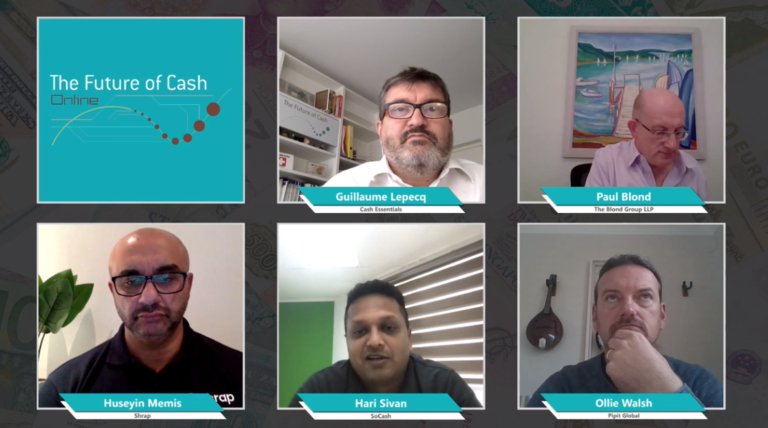The Future of Cash – from an Asian Perspective
In place of the annual in-person Future of Cash Conference, a series of highly virtual events have been staged. The most recent was an Asia-Pacific-focused two-day virtual conference held across four themed sessions in July. A great line-up of industry experts presented a range of insights and updates before sharing the panel to answer delegate questions. I was fortunate to join Conference Chair Guillaume Lepecq in moderating these panel discussions
Session One kicked off with three distinguished central bank panellists: Antti Heinonen, former Director, Banknotes at the European Central Bank and current Chair of the BanknoteA banknote (or ‘bill’ as it is often referred to in the US) is a type of negotiable promissory note, issued by a bank or other licensed authority, payable to the bearer on demand. More Ethics Initiative; Alex Bau, Director, Data and Policy Analysis at the Federal Reserve System CashMoney in physical form such as banknotes and coins. More Product Office in San Francisco; and Ralph Meris, Deputy Director of the Bangko Sentral ng Pilipinas (BSP). The three were able to provide data rich updates on cash trends across Europe, the US and the Philippines/Southeast Asia.
The Cash Paradox
A common and recurring theme – referenced several times during the conference – was the ‘Cash Paradox’, namely the disconnect between significant growth in currencyThe money used in a particular country at a particular time, like dollar, yen, euro, etc., consisting of banknotes and coins, that does not require endorsement as a medium of exchange. More put into circulation and the sometime steep decline in cash use during the height of the COVID 19 pandemic. This paradox emphasises the role of cash, not only as a means of paymentA transfer of funds which discharges an obligation on the part of a payer vis-à-vis a payee. More, but importantly as a store of wealth, especially in these troubled times.
Panellists were keen to point out that while cash payments were down, with lockdown, domestic and international movement restricting economic activity, so too were many other forms of payment use. Questions were asked about whether moves towards contactless transactions, encouragement to use cards and apps for payments and, in some instances, active discouragement in the use of cash (based upon now disproven health grounds), was a permanent shift changeThis is the action by which certain banknotes and/or coins are exchanged for the same amount in banknotes/coins of a different face value, or unit value. See Exchange. More in payment behaviour or a temporary response to the pandemic.
I think the jury is still out on that, and when currency in circulation volumes and trends return to more established norms, this will no doubt be a topic for further discussion at the upcoming Future of Cash events.
As well as the global trends, we also heard an in-depth description of the BSP’s Cash Service Alliance initiative moving considerable cash handling activity from the BSP to a number of commercial banks, with consequent supply chain efficiency gains. Expedited by the pandemic and restrictions on movement, it reinforced that there are still many efficiency opportunities to ensure the costs of handling cash are maintained.
The Importance of Sustainability
Indeed, the importance of a sustainable cash infrastructure if only as a backup to other not always reliable payment forms was another area of significant debate. The question was asked ‘if cash is only really needed as a precautionary store of wealth; will the private sector have any need or interest to support it? Do central banks need to intervene and underwrite cash to ensure its future?’
In the second session we continued to draw experiences during the pandemic, considered lessons learned and optimistically looked to the future. Four panellists – Petteri Lilberg, futures literacy experts at tank Demos Helsinki; Ian Woolford, Head of MoneyFrom the Latin word moneta, nickname that was given by Romans to the goddess Juno because there was a minting workshop next to her temple. Money is any item that is generally accepted as payment for goods and services and repayment of debts, such as taxes, in a particular region, country or socio-economic context. Its onset dates back to the origins of humanity and its physical representation has taken on very varied forms until the appearance of metal coins. The banknote, a typical representati... More and Cash at the Reserve BankSee Central bank. More of New Zealand, Te Pūtea Matua; and academics Franz Seitz from Weiden Technical University of Applied Sciences and Gerhard Rösl of Ostbayerische Hochschule Regensburg – shared the stage.
Plausible Future Scenarios
Petteri´s presentation provided a systematic framework for considering a plausible future for cash drawing on the competing needs of Inclusion, Privacy and Sustainability. We walked through three scenarios – Global Recovery, Return of the State and Let’s Get Digital – and considered the role of and impact on cash in each case.
Spanning the globe from Helsinki to Auckland, we heard from Ian Woolford on cash stewardship and a number of specific initiatives, including the planned fundamental redesign of New Zealand’s cash system ensuring it is fit for future purpose. Ian outlined the RBNZ’s plan to issue three consultation papers on Money and Cash Stewardship, Central Bank Digital Currencies and, later, Cash System Redesign. We look forward to learning more about these soon.
Professors Seitz and Rösl talked to their recent paperSee Banknote paper. More ‘Cash and Crises’, referencing the cash paradox and concluding that in times of crises (of all types) cash demand grows. Their analysis exposed differences in denominational demand but concluded that cash remains both an insurance device and safeSecure container for storing money and valuables, with high resistance to breaking and entering. More haven.
Different Cash CycleRepresents the various stages of the lifecycle of cash, from issuance by the central bank, circulation in the economy, to destruction by the central bank. More Models
Day Two started with a session entitled the ‘Next Gen Cash Cycle.’ Our panellists were Hiroshi Fujiki of Chuo University in Japan; Jodie Leetet, Value Stream Lead at Australian commercial bank ANZ; V Balasubramanian, at Indian cash logisticsThe term originates from military language and refers to the movement and provisioning of troops at war. In today’s business vocabulary, it refers to the management in particular, the transportation, storage and distribution of finished goods. More company FSS CashTechThe expression was first coined by CashEssentials and is the encounter of cash and technology. It brings together innovative companies who leverage software and modern communications technology to improve cash services: access to cash; acceptance of cash; and the efficiency of the cash cycle for all stakeholders. More; and Ben Thorpe, President, APAC, GLORY Global Solutions. Each speaker drilled down into their specific fields of expertise and shared some fascinating insights into the potential future direction for cash.
Prof Fujiki spoke to his study of consumer payment behaviour in response to a decline in bank operated ATMs in Metro Tokyo, reporting on which consumers sought out other ATM locations of their own bank, used third party or other ATMs, or moved to non-cash payment methods. The trends were correlated to consumer financial literacy and provided some important lessons surrounding consumer education and inclusion as banks seek to rationalise infrastructure and reduce costs.
Jodie Leetet described Australia as a ‘cash light’ country, referring to the growth in non-cash payment choices, largely contactless transactions. She concluded that ‘there is still much public good in being good with cash’ and that ‘no one banking institution can and will hold the answer as both customers and banks exit the physical branch and ATM model.’
By contrast the next speaker, V Balasubramanian, put up a strong defence for cash in India, trumpeting the much-used adage that ‘cash is king.’ Bala explained how cash is intrinsic to Indian life and an important safeguard against insecurity and shortages. He emphasised the importance of offering both cash out and cash in – access and acceptance – across the many thousands of villages and towns in India, and how cash and ATM provision are a catalyst to financial inclusionA process by which individuals and businesses can access appropriate, affordable, and timely financial products and services. These include banking, loan, equity, and insurance products. While it is recognised that not all individuals need or want financial services, the goal of financial inclusion is to remove all barriers, both supply side and demand side. Supply side barriers stem from financial institutions themselves. They often indicate poor financial infrastructure, and include lack of ne... More and digital adoption.
Ben Thorpe at Glory took us on a cash history lesson, culminating in his company’s vision for Cash 4.0, and opportunities to embrace technology to make the cash cycle more efficient and cost effective and how the cash industry remains ripe for disruption.
CashTech to the Fore
Ben’s presentation was a perfect introduction to our fourth and final session on CashTech, the term being used to describe a range of emerging technology led solutions that are bringing fresh thinking to the cash arena (see page 12). Our panel of cash entrepreneurs included Huseyin Memis, Chief Commercial Officer, at Shrap; Hari Sivan, Founder and CEO of SoCash based in Singapore; and Ollie Walsh, Co-founder and CEO of the international cash transaction platform Pipit Global.
Huseyin introduced us to Shrap, coins reimagining, and a digital alternative to issuing and handling coinA coin is a small, flat, round piece of metal alloy (or combination of metals) used primarily as legal tender. Issued by government, they are standardised in weight and composition and are produced at ‘mints’. More. He described the Shrap app to store loose change as a convenient alternative to pockets or jars full of heavy metal and talked to the company’s involvement in a number of UK based trials supporting access to cash. As a long-standing cash logistics industry expert, he also talked to some of the high costs of coin handling and the opportunities to reduce coin at the point of sale.
Hari Sivan expanded on the work of So Cash, first introduced in Ben Thorpe’s presentation, and how his company’s app to match customer cash needs with retailer surplus cash has created the largest cash access network across Singapore at a time where traditional bank branches and ATMs are contracting. Another example of digital technology being used to support rather than fight against cash use.
Finally, Ollie Walsh provided a fascinating insight into his Irish Fintech company Pipit Global – a for profit, social impact B2B platform that provides a cost-effective way of enabling often unbanked migrant workers to remit payments home. Pipit offers a solution to counterAutomatic device for the counting of banknotes or coins. More the high cost of cross border payments, again showing how cash can be an intrinsic part of a digital landscape and enabler to greater financial inclusion.
At the end of two days of expert opinion and shared insights I was struck by how some of the traditional roles for cash have been significantly impacted by the pandemic but heartened by the Cash Tech and other opportunities to drive improved efficiency and lower costs across the industry.
In many ways the conference raised more questions than answers and started conversations that are yet to play out. As such, it provided the perfect springboard for continuing the Future of Cash debate.
Next Future of Cash Events
The in-person Future of Cash event planned for 10-11 November in Madrid has been postponed until 13-15 September 2022, in anticipation of travel restrictions finally being lifted by then.
In the meantime, a series of virtual events and roundtable sessions are planned over the coming months. They include a two-day webinar entitled Cash & CBDCs on 11-12 November.


